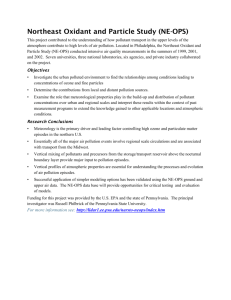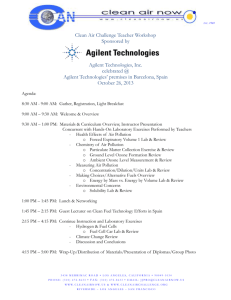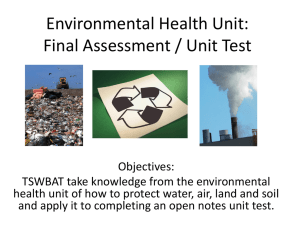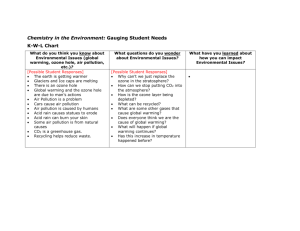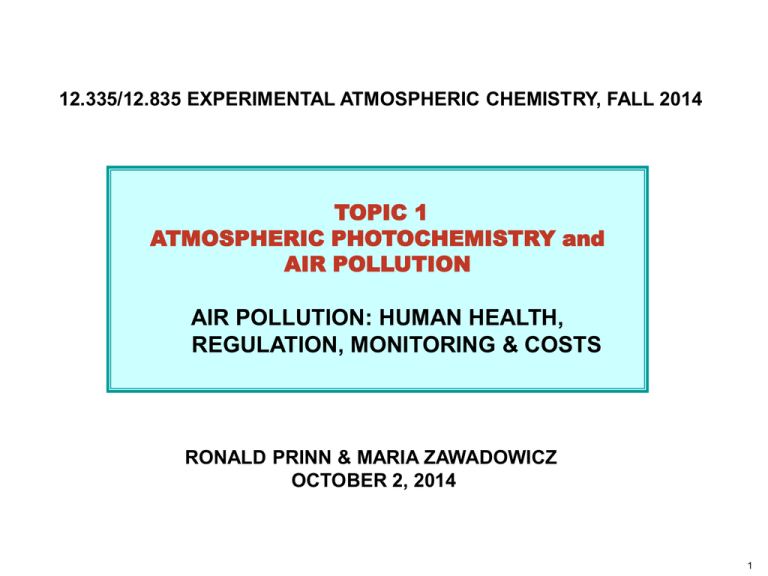
12.335/12.835 EXPERIMENTAL ATMOSPHERIC CHEMISTRY, FALL 2014
TOPIC 1
ATMOSPHERIC PHOTOCHEMISTRY and
AIR POLLUTION
AIR POLLUTION: HUMAN HEALTH,
REGULATION, MONITORING & COSTS
RONALD PRINN & MARIA ZAWADOWICZ
OCTOBER 2, 2014
1
INCORPORATING METEOROLOGY IN THE BOX MODEL
1. USE THE u MEASUREMENTS TO ALIGN THE MODEL x AXIS AND USE IN THE
BOX MODEL ADVECTION TERMS.
2. USE THE T & u MEASUREMENTS TO CALCULATE A RICHARDSON NUMBER TO
HELP CHOOSE SUITABLE texchange VALUES (e.g. unstable~1 hour, neutral~6 hours,
stable~12 hours).
TOP OF BOUNDARY LAYER
© Cory Cripe. Some rights reserved. License: CC BY-NC 3.0.
This content is excluded from our Creative Commons license.
For more information, see http://ocw.mit.edu/help/faq-fair-use/.
3. USE TEMPERATURE SOUNDINGS OR HAZE LAYER HEIGHT TO ESTIMATE Z
2
COMPONENTS OF ATMOSPHERIC CHEMISTRY MODELS
DYNAMICAL EQUATIONS
Winds , Eddy diffusion coefficients
MASS CONTINUITY EQUATION
MOMENTUM EQUATIONS
Temperature
THERMODYNAMIC EQUATION
CHEMICAL
Rates
for
Heating
= Pi - Li -
EQUATIONS
U.
V
r
Fo
ph
Flu
xe
s
.([i]V)
~
n
tio
ia
oc
iss
od es
ot rat
{
∂t
∆
RADIATION
For
Unpredicted
green house
gases use
scenarios or
extra polations
For Source gases
use predictions,
extra polations
or scenarios
∂ [i]
Concentrations
(O3, etc.)
Rates for Chemistry
{
CONTINUITY EQUATIONS
TRANSPORT,
CHEMISTRY AND
RADIATION
COMPONENTS
IN COMPLEX 3D
MODELS
Interactions Between Air Pollution and Climate
Stratosphere
UV
O2
NO2
O3
NO
O2
UV
OH
HNO3
O( D)
OH
N2O
Lightning
H2O
CO2
Hydrosphere
H2SO4
HO2
O2
1
CO
OH
CH4
CO2
OH
CFCs
BC
SO2
Biosphere & Human Activity
Greenhouse Gases
Primary & Secondary Pollutants
Absorbing Aerosols (BC)
Reactive Free Radical/Atom
Less Reactive Radicals
Reflective Aerosols
Figure by MIT OpenCourseWare.
3
The spatial
grid
We divide the earth’s
atmosphere into a
finite number of boxes
(grid cells).
Assume that each
variable has the same
value throughout the
box.
Write a budget for each
each box, defining the
changes within the
box, and the flows
between the boxes.
Figure © Henderson-Sellers: A Climate
Modeling Primer.
© John Wiley & Sons, Inc. All rights reserved. This content is excluded from our Creative
Commons license. For more information, see http://ocw.mit.edu/help/faq-fair-use/.
4
Air Pollution and Human Health
(Reference: Adapted from http://www.air-quality.org.uk/18.php)
Introduction Pollution-related health problems result from primary pollutants such as sulfur
dioxide, nitrogen dioxide, and some particulates, and secondary pollutants like ozone and
particulates produced from primary gas-phase pollutants.
Particulates The extent to which particulates are considered harmful depends largely on their
composition. Sea salt, for example, is believed to have a positive effect on health. Man-made
sources of particulates, however, are rarely harmless. In towns and cities, these are
extensively from diesel vehicle exhausts. The effects of man-made particulate emissions are
considered detrimental due to their composition, containing mainly unburned fuel oil and
polycyclic aromatic hydrocarbons (PAHs) that are known to be carcinogenic among
laboratory animals. Particulates may originate from many other sources including cement
manufacturing processes, incineration and power generation, so localized particulate pollution
is common. The sizes of particles are important when assessing their effects on health. PM2.5
and PM10 as well as total suspended particulates are routinely monitored. This is due to the
fact that particles of less than 2.5-10 micro-meters (mm) in diameter can penetrate
deep into the lung and cause more damage, as opposed to larger particles that may be
filtered out through the airways' natural mechanisms.
Ozone Ozone is created by the action of sunlight on CO, volatile organic compounds (VOCs)
and nitrogen oxides over 1-3 day time periods. This results in ozone being widely dispersed
as a pollutant, and can form in greater concentrations in rural areas. As ozone concentrations
are particularly dependant on sunlight, episodes are always likely to develop following
sustained periods of warmth and calm weather. Ozone is a toxic gas that can bring
irreversible damage to the respiratory tract and lung tissue if delivered in high
quantities. Levels during air pollution episodes range up to 100-250 ppb (0.1-0.25
ppm). At these concentrations ozone impairs lung function and causes irritation to
the respiratory tract. Asthmatics are especially affected.
5
Oxides of Nitrogen The oxides of most concern are nitric oxide (NO) and nitrogen dioxide
(NO2). The latter is more damaging to health, due to the toxic nature of this gas. NO
is emitted to the atmosphere as a primary pollutant, from traffic and power stations, and is
oxidized to nitrogen dioxide following dispersal. Health effects of exposure to NO2 include
shortness of breath and chest pains. The effects of NO include changes to lung function at high
concentrations.
Carbon Monoxide Carbon monoxide combines with hemoglobin, the oxygen carrying
component of the blood stream, to form carboxy-hemoglobin (COHb) which can be lifethreatening in high doses. The effects of CO pollution are more damaging to pregnant women
and their fetus. Research into smoking during pregnancy shows that concentrations within the
blood stream of unborn infants is as high as 12%, causing retardation of the unborn child's
growth and mental development.
Lead Lead is still a serious air pollutant especially to those living near to areas of dense traffic
in cities where leaded fuel is still used or to coal-fired power plants. Damage to the central
nervous system, kidneys and brain can result when levels in the blood reach
concentrations of 800 mg/liter. Much of the concern regarding pollution from lead centers
around its effects on child health. Children exhibit vulnerability to the toxic effects of lead at
much lower concentrations than for adults. There is a strong link between high lead exposures
and impaired intelligence.
Sulfur dioxide The health effects of sulfur dioxide include heart disease and bronchitis. SO2
emissions have been significantly reduced through legislative measures in developed countries.
Asthmatics are especially sensitive for whom concentrations above 125 ppb may result in a fall
in lung function. Tightness in the chest and coughing may also result at levels approaching 400
ppb. At levels above 400 ppb the lung function of asthmatics may be impaired to the
extent that medical help is required. Sulfur dioxide pollution is more harmful when
particulate and other pollution concentrations are also high (the synergistic effect).
6
Volatile Organic Compounds (VOCs)
Some VOCs are directly harmful, including: Benzene which may increase susceptibility to
leukemia, if exposure is maintained over a period of time; Polycyclic Aromatic Hydrocarbons
(PAH) some of which can cause cancer (there are several hundred different forms of PAH, and
sources can be both natural and man-made); Dioxins, whose sources include manufacturing of
organic compounds as well as the incineration of wastes and various other combustion
processes involving chlorinated compounds, and which has health effects due to inhalation
and ingestion (e.g. dioxins entering the food chain from soils); 1,3 Butadiene, for which there is
an apparent correlation between exposure and a higher risk of cancer, and which is produced
from manufacturing of synthetic rubbers, gasoline-driven vehicles and cigarette smoke.
General Air Quality Problems
Air quality indoors Many different compounds are contained in tobacco smoke, including carbon
monoxide, ammonia, dioxins and PAH; the latter two are thought to be carcinogenic. Other
sources of indoor pollution include particulates from mineral fibers as well as household dust.
Dust in buildings is known to cause problems including fatigue and nausea. One of the most
pressing concerns with indoor air pollution is with carbon monoxide built up from gas, oil or
wood fired appliances. Open gas flames and fire places also produce BC.
Asthma and air pollution There has been a steady rise in the number of reported asthma cases
since the 1970s, and air pollution problems are believed to be a significant (but not sole)
contributor to the rise. High concentrations of nitrogen dioxide, sulfur dioxide, ozone and
particulates (especially PM10) can all trigger breathing difficulties in asthmatics.
7
NATIONAL
AMBIENT
AIR QUALITY
STANDARDS
(NAAQS)
8
9
OZONE MONITORING
NETWORK
IN NEW ENGLAND
High concentrations of ozone near ground
level can be harmful to people, animals,
crops, and other materials. Ozone can
irritate your respiratory system, causing
you to start coughing, feel an irritation in
your throat and/or experience an
uncomfortable sensation in your chest.
Ozone can aggravate asthma, and can
inflame and damage cells that line your
lungs. Ozone may also aggravate chronic
lung diseases such as emphysema and
bronchitis and reduce the immune
system's ability to fight off bacterial
infections in the respiratory system. Lastly,
ozone may cause permanent lung
damage. These effects can be worse in
children and exercising adults
Image courtesy of EPA.
10
O3 at BOSTON - LONG ISLAND STATION (Operating 1999 to Present)
Year
Total
Days
>
0.084
1st
High
(ppm)
Date
2nd
High
(ppm)
Date
3rd
High
(ppm)
Date
4th
High
(ppm)
Date
2007
0
0.082
Sept
25
0.080
April
23
0.076
Sept
26
0.073
Aug 3
2006
0
0.083
June
22
0.083
July 2
0.083
July
18
0.079
July 1
2005
5
0.095
June
25
0.091
June
26
0.089
Aug
11
0.086
June
24
2004
1
0.094
June 8
0.081
July
22
0.080
July
23
0.079
July
30
2003
1
0.102
June
27
0.083
June
25
0.078
June
26
0.078
July 4
2002
10
0.126
Aug
13
0.117
Aug
14
0.102
0.102
Sept 9
2001
9
0.111
June
20
0.107
June
19
0.100
Aug 2
0.094
July
24
2000
0
0.084
June
10
0.073
June 1
0.072
Aug 9
0.070
June 2
1999
4
0.102
July
16
0.100
June
24
0.089
June 1
0.087
May
31
July 3
MAP
*
*
11
REGIONAL OZONE HEALTH ALERTS IN NEW ENGLAND
BASED ON THE MONITORING NETWORK. Human health is
affected by exposure to ozone expressed as a function of the
AOT40 Index (AOT40 = hourly ozone exposure above 40 ppb in
units of ppb.hr/mo; see earlier lecture for USA AOT40 map)
Image courtesy of EPA.
12
Air Pollution Economic Effects
(Yang et al, Report 113, MIT Joint Program on the Science & Policy of Global Change:
http://globalchange.mit.edu)
Approach
Extensive data set on epidemiological effects of air
pollution exposure
Resultant illness, death, demand for medical services
Lost labor, leisure, diversion of resources to medical and
health services introduced into MIT economic model
Results based on historical pollution levels
evaluated US benefit of air pollution regulation, and
remaining burden of air pollution (1975-2000)
13
Change in Welfare
450
Benefit of Policy is avoided
health costs due to the
policy.
Remaining Cost of Pollution
decreases due to lower
pollution levels, but is offset
by increases due to rising
income and population.
Welfare is a measure of total
consumption of goods and
services.
$ billions 1997 USD
400
350
300
250
200
150
Benefit of Policy
100
Cost of Pollution
50
0
1975
1980
1985
1990
1995
2000
2005
Year
Benefits of air pollution regulation and costs of remaining pollution.
Figure by MIT OpenCourseWare.
Welfare
350
200
250
$ billions USD
$ billions USD
300
200
150
100
50
0
1975
1980
1985 1990
Year
(a) Benefits
1995
150
100
50
0
1975
2000
PM
O3
1980
1985 1990
Year
1995
2000
(b) Costs by Pollutant
Figure by MIT OpenCourseWare.
14
MIT OpenCourseWare
http://ocw.mit.edu
12.335 / 12.835 Experimental Atmospheric Chemistry
Fall 2014
For information about citing these materials or our Terms of Use, visit: http://ocw.mit.edu/terms.

